| NEUMANN - TELEFUNKEN - TAB |
|---|
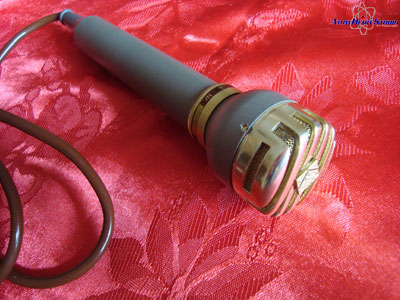
Telefunken D 19 BKi
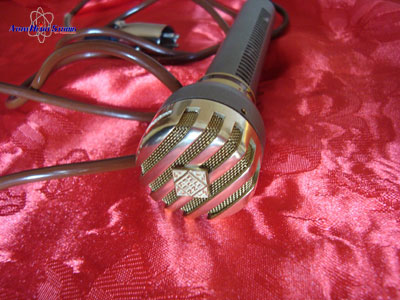
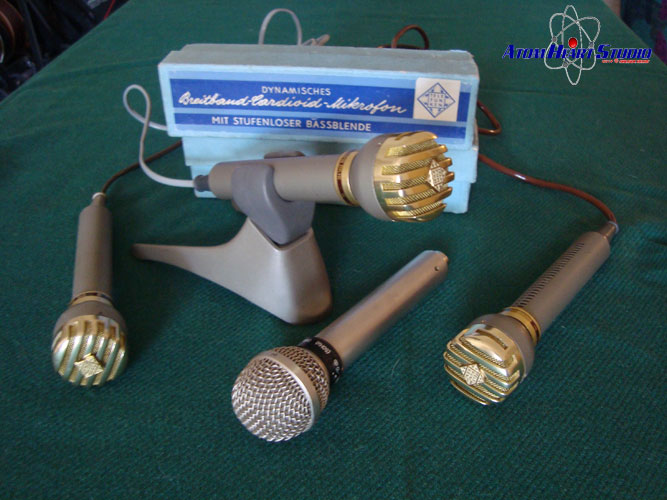
Telefunken D19 BKi and AKG D 24 are identical except for the bodyl.
TELEFUNKEN-MITSUBISHI MX80 DIGITAL ON 1/4 TAPE RECORDER MASTER STEREO
MX80 pdf - - - Magnetophon 15A pdf
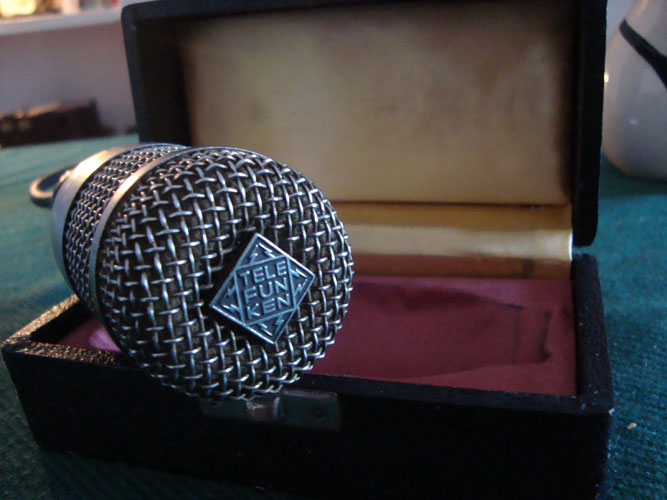
Telefunken ELA M 411 - AKG D 17
The D 17 is a dynamic microphone with a cardioid polar pattern for vocal and speech applications in announce booths, public address and sound reinforcement applications. It features the same capsule as the AKG D 12 and AKG D 20 but does not have the special bass resonance-chamber of the other models, resulting in a flatter frequency response. The microphone element is protected against stray magnetic fiedls achieving a maximum noise reduction of 20 dB. It uses an AKG 3 B 17 C connector (DIN 41624). It was also available on a 60 Ohm impedance version as the D17/60. Telefunken (M 411) and Siemens WSW badged versions are also common. The D17 microphone is designed for rugged service under severe conditions, yet it is elegantly styled. |
|---|
Telefunken ELA M 411 & Beatles (Live in Paris)
.jpg)
.jpg)
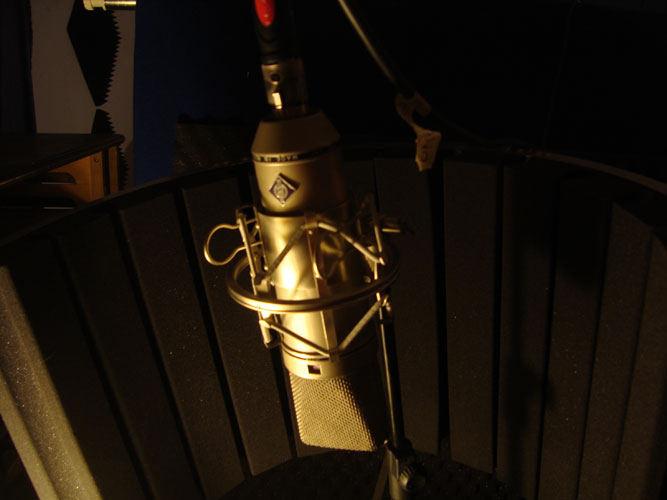
Neumann U87
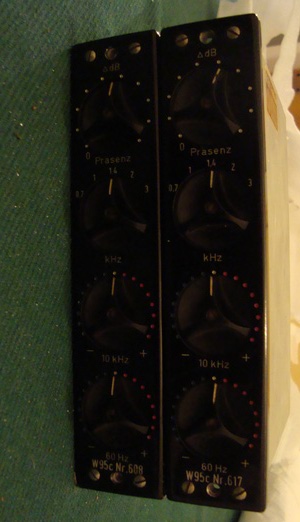
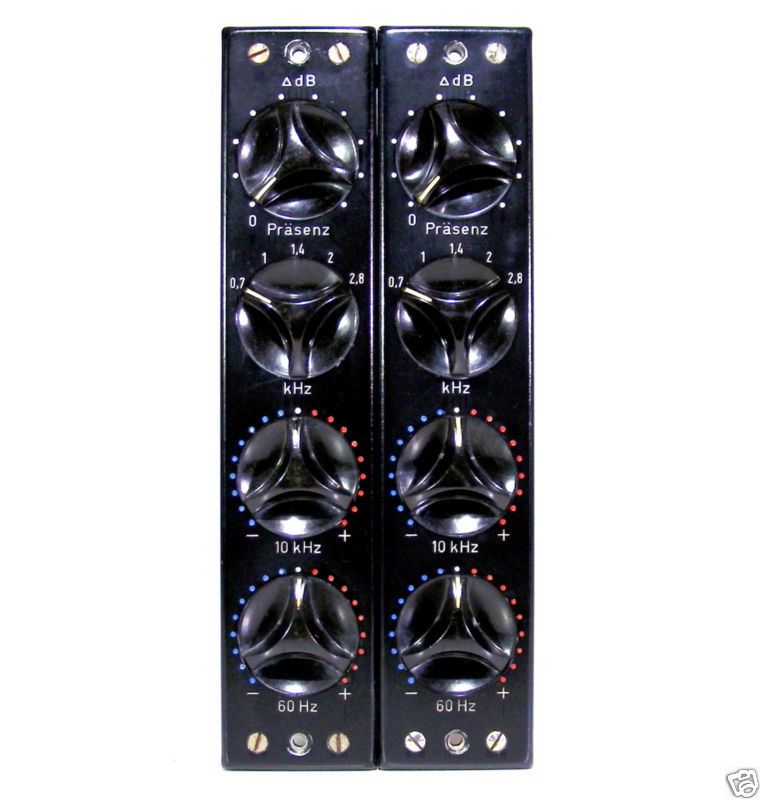
Telefunken TAB w95c Master EQ
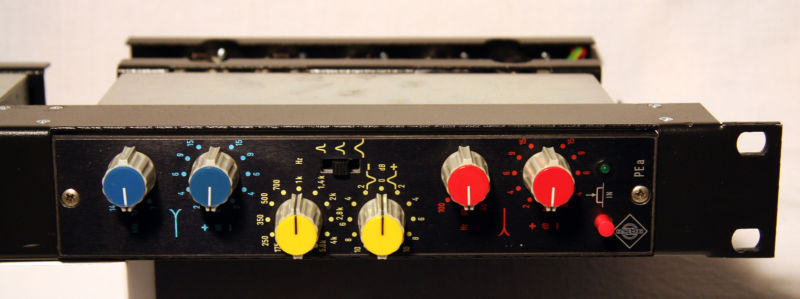
W495b Master Eq
Telefunken 376
I consider the V376 a world class "desert island" type mic pre which works well on just about anything you throw at it and is subjectively, as good as any Neve or API unit ever made. It was designed and built by the German company TAB to replace their classic tube V76 mic pre and it sounds similiar but costs about 1/3 as much on the used market and is a great value. At this level, the differences and preferences come down to taste. I would describe the sound as natural, warm, very open on both the top and bottom, and (when in proper repair) the V376 is amazingly noise-free. With 76 db's of pure clean gain, its just THE BEST MIC PRE EVER for ribbon mics and other low output mics like EV RE20's. The V376 was a standard among northern European radio and TV broadcast networks from the mid 1960's well into the mid 1990's. Although built like a tank, some of the units you find were in daily use 30 years and may require service. Oliver Archut of Tab-Funkenwerk has worked on mine. Some of the V376 units will be branded TAB and some will say Telefunken but all were made by TAB.
With its controls on the front, the V376 is made to be rack mounted and requires a good stable 24 volt power supply (the MUCH larger tube V76 had a built in power supply). There are pre-made racks you can buy from places like vintagecity.de for the V376 or anyone who racks vintage modules can rack them. I have an original TAB rack and power supply but its wider than the standard 19" and can be a challenge to mount. The companion compressor-limiter, the U373a, is also EXCELLENT.
NEUMANN 476B
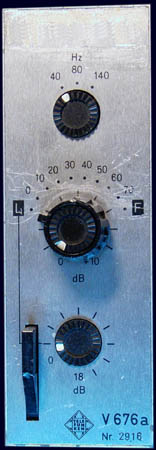
V 676a
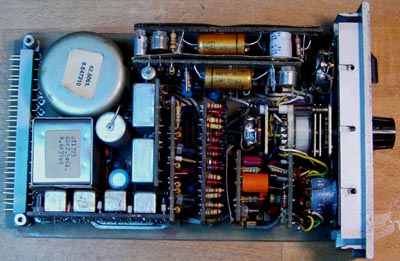
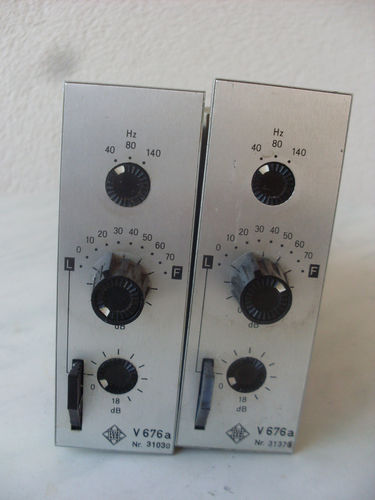
Trick: The V 676 with a ribbon mic is the best for guitar amp |
|---|

TAB MK 40 - V376a & W395a
Neumann U 473
Robbie Williams at Abbey Road with a custom made M7 capsule mic
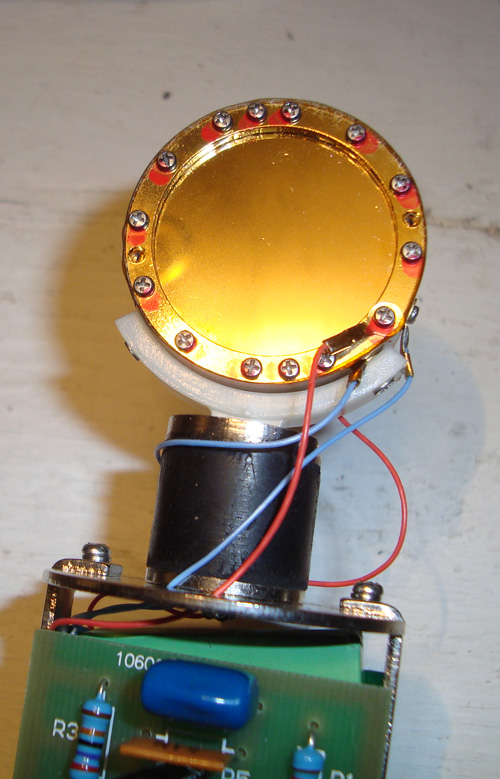
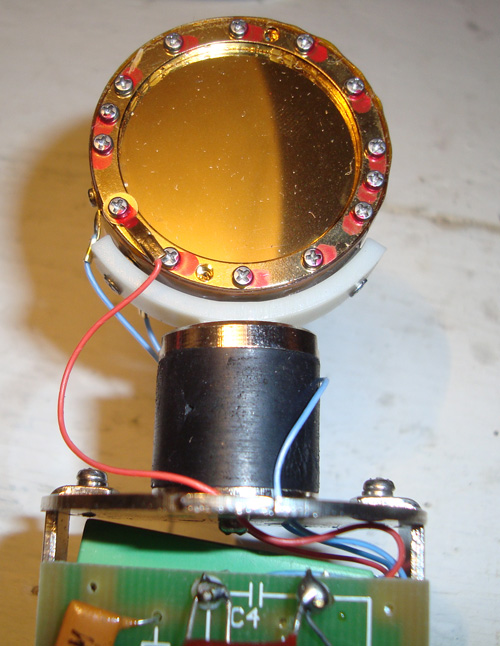
Apex 460 with CK12 Peluso capsule
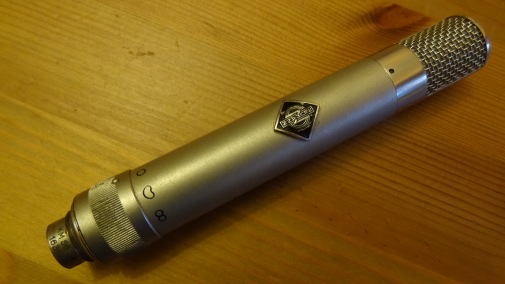
KM56
UM 57
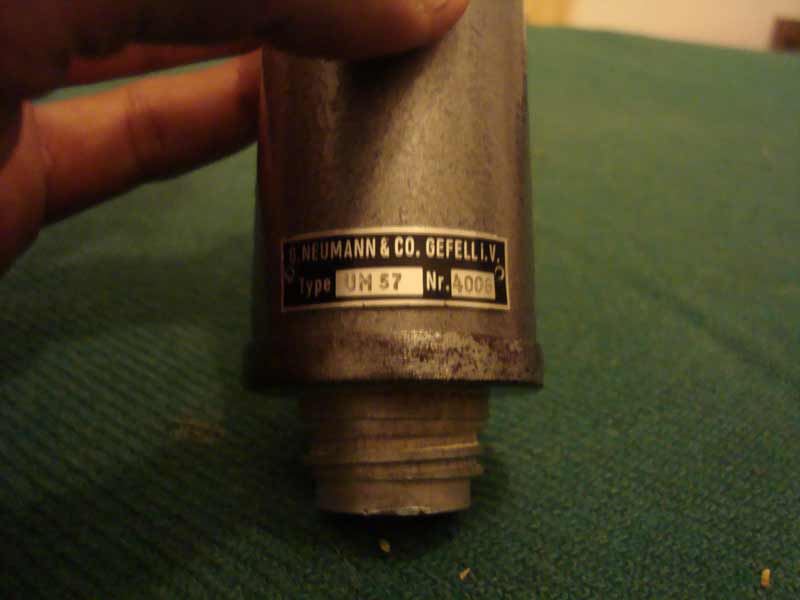
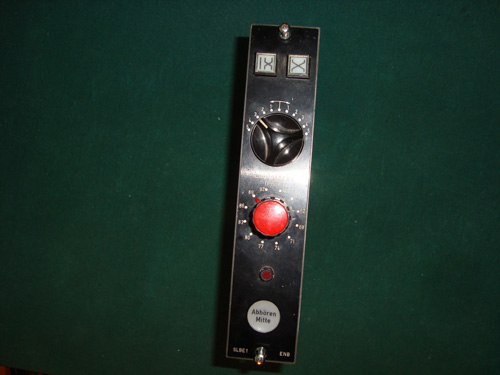
Maihak Limiter LNB1
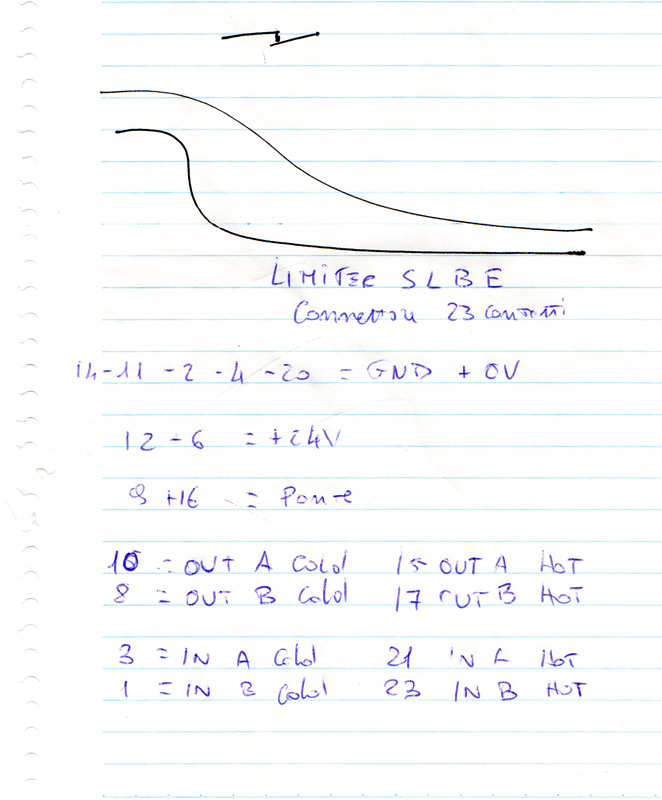
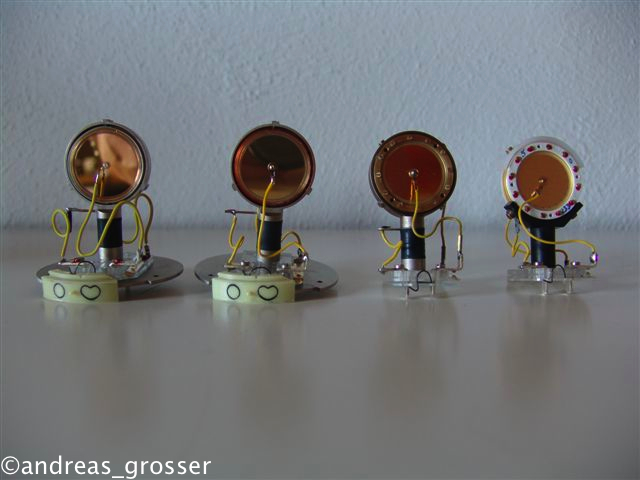
The evolution of M7 capsule. Only the first 5.000 numbered M7 capsule made in Berlin
were put in the first model of Neumann U47.
Early U47 (and U48) mics contained Neumann’s M7 capsule, in which the brass backplate was covered with a thin PVC diaphragm.
PVC ages poorly, and as early as 1958 the Neumann factory was using the M7’s successor,
a capsule known as the K47/49, which used a metallized polyester diaphragm.
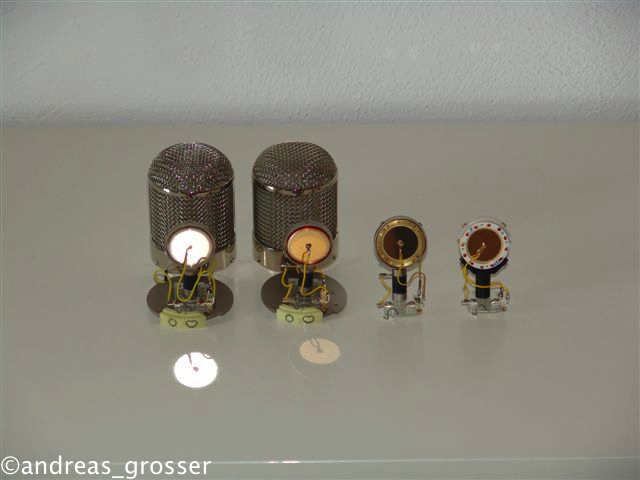
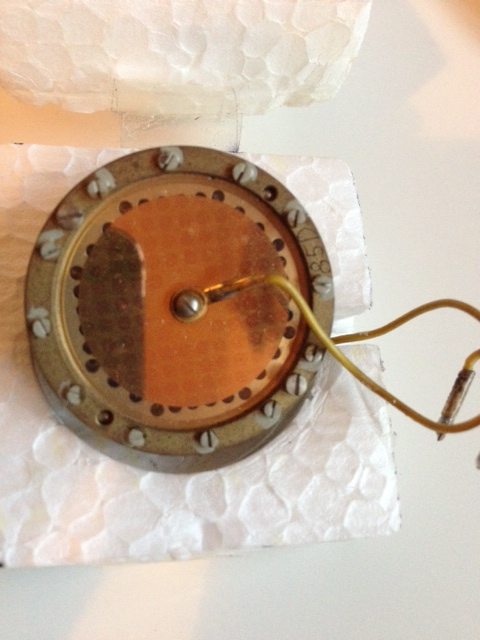
Neumann K67 capsule for U67
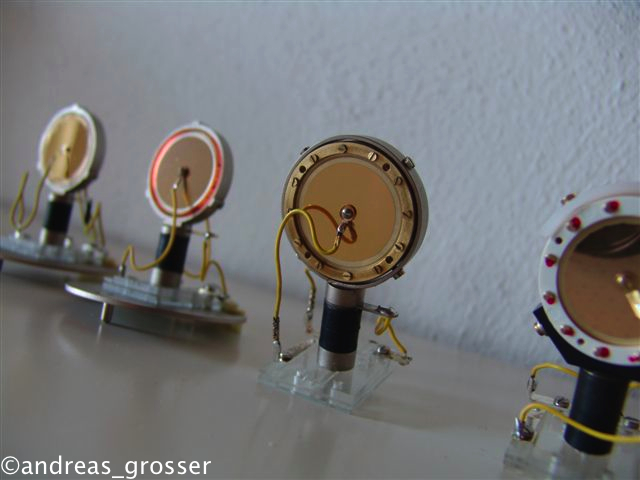
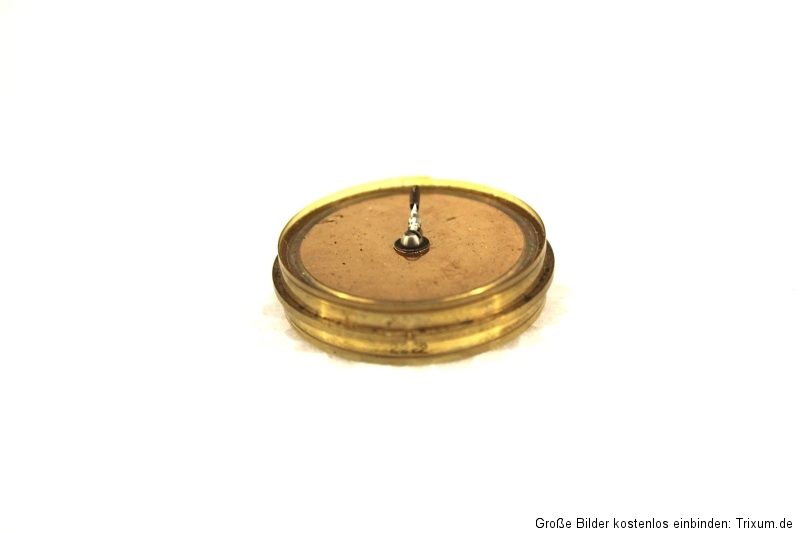
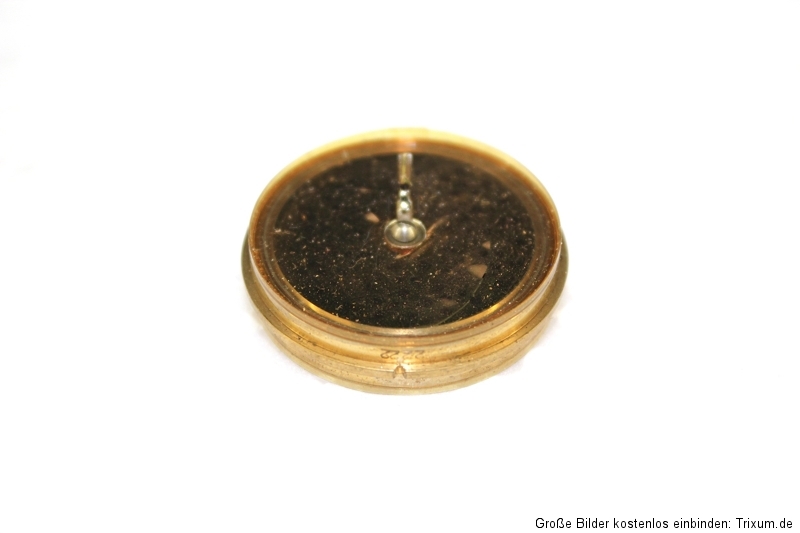
Original U47 capsule M7 n° 2222 made in Berlin
Neumann (Berlin) made the M 7, M 8 and M 9 capsule heads for their original "bottle" microphone, model CMV 3. As far as I know, that microphone series was discontinued by the end of World War II.
Neumann (Berlin) built the M 7 capsule into the U 47 and M 49 microphones after the war, but they didn't make any more "bottle"-type microphones for the old removable capsule heads. That was done only by the people working in Gefell (the CMV 5 and later the CMV 563, for example).
Furthermore, Neumann (Berlin) changed over to the use of Mylar membranes starting in the early 1960s. So by 1967 (the year which you mentioned), they weren't making the M 7 capsule any more, but rather a capsule with the same backplate plus Mylar membranes, generally called the K 47 or the K 49. By 1967 the U 47 had been discontinued but the U 47fet had not yet been introduced; the M 49 was still in production.
I don't know of any model U 57 from either Neumann (Berlin) or from Gefell. If you mean UM 57--that was made in Gefell, but never in Berlin--and it wasn't a microphone that used interchangeable capsules! At that time, the CMV 563 would have been the Gefell model that accepted M 7, M 8, M 9 or M 55 K capsule heads. And finally, I don't think that Neumann (Berlin) ever made any capsule, capsule head or any other item called "M 55"--those were made exclusively in Gefell.
M8 Capsule
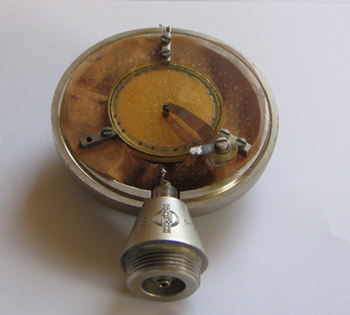
This working transducer came out of Neumann-Gefell M8 # 2876 bayonet-mount capsule,
and it needs the Neumann M8 lollipop capsule housing because of the spring / tongue contact in order to function.
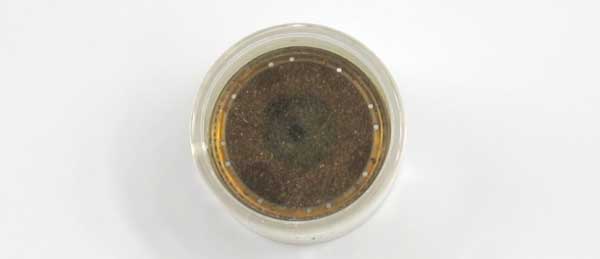
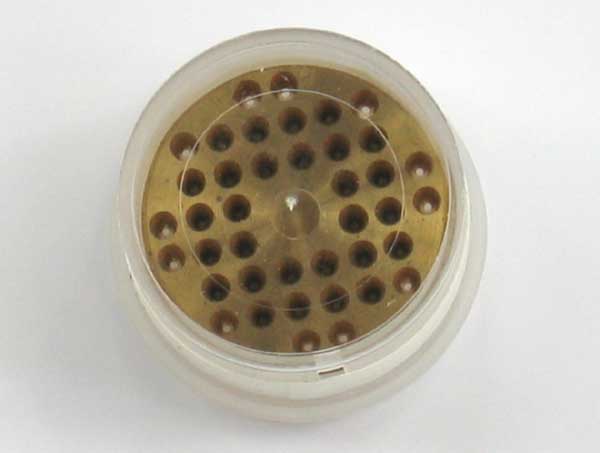
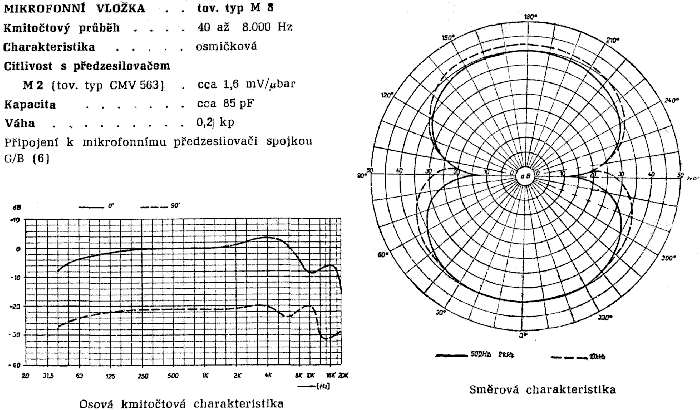
Telefunken ELA M 250
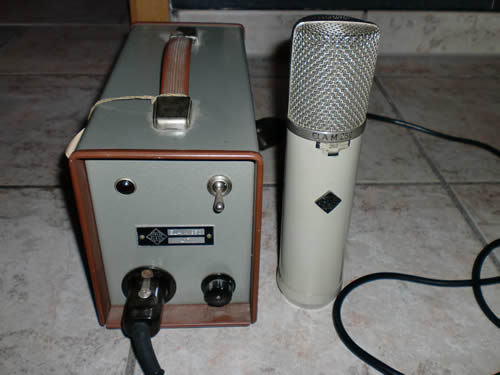
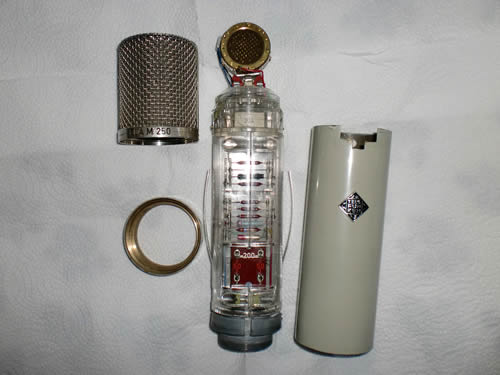
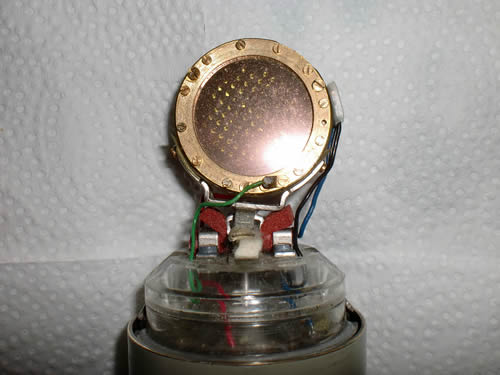
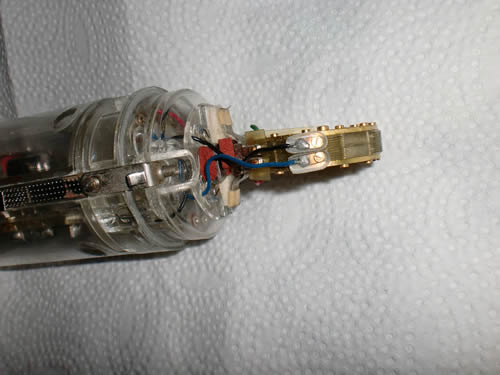
TELEFUNKEN/TAB/EAB/NEUMANN/SIEMENS
The V72 studio mic pre-amplifier.
The V72 was developed at the NWDR (North West German Radio) in the time period of 1949 to 1952 as a microphone and main studio amplifier under the technical supervision of Prof. Nestler the former Head of R&D of Telefunken ELA (Electro Acoustic) Lab.
Following the Stockholmer Radio conference ,where Europe set the beginning of the Ultra Short Wave Radio or in better terms FM radio, new equipment with a better frequency response and S/N ratio was needed. Because most pre-war equipment had been deported or destroyed the NWDR developed a complete new standard for the German radio network in cooperation with the IRT in Hamburg (Institute for Broadcast Technology).
The V72 was modeled on the basis of the V41 (developed in 1928 by Telefunken), but with modern parts like the Noval glass tubes and in a smaller housing the "Danner" cassette module. The first 300 units were build at the NWDR Zentraltechnik up to serial#100 and to Serial#300 by Maihak with a set of EF40 (the post war version of the EF12), but later changed to a better version of the EF40, the EF804s.
The V72 is a self contained amplifier with a fixed gain; it was originally used as a microphone amplifier (in use with a Neumann W75k high pass filter) and as a buffering amplifier to make up for loss of the passive fader like the Danner MR66/88 and Eckmiller W86 EQs. Up to 1955 it was the standard preamplifier in German radio stations; with the introduction of the V76, it was pushed back as an input module, then only used as a buffering amplifier. In 1963 it was decomissioned by the IRT and replaced by the V72t transistor version.
An estimated 25000 V72 were built for the German Radio Network alone with a fixed gain of 34dB, by several different companies. The early ones were build by Maihak and Telefunken; in 1954 Siemens and TAB joined the production team. Aside from the German radio stations, the V72 was used by most of the European Recording Companies like EMI, Decca/Telefunken, etc. Those units were a bit different,with a fixed gain of 40 dB and lower input impedence.
Telefunken used them as standard preamplifiers for their broadcast division. In 1960 AEG-Telefunken, which was the world's biggest manufacturer of broadcast systems, sold these units mainly to radio stations in South America, Africa and the Middle East, where most of them are still in use today. In 1966 the production stopped at Telefunken; Siemens stopped the production in 1964 but built the V72b version up to 1966. TAB was the only company that built the V72a up into the 70s.
Today the V72 is still in demand, but most units are now at least 34 years old and need to be rebuilt or refurbished. The electrolytic caps of the power supply are dried out and need to be replaced; the silkwire of the unit falls apart, and in most cases it shorts out the input/output x-former.
Technically speaking, there is a family of V72 type amplifiers that were built around the V72 circuit: the V71, V77 and V78. And the close relatives to the V72 are those units that matched the technical data of this little giant, but used a different circuit,V72a (V74a) V72b (V70/V77b).
The V71 was only made by Malotki and was a half size Danner module (without power supply) that incorporated the V72 circuit. The gain could be set with a resistor from 19 to 43 dB and needed an external N52 power supply.
The V77 was a Siemens made supercharged V72 with a maximum gain of 80 dB. It produced sound like a V72 but with the gain and plus of the V76; with an external switch (W77) the gain could be adjusted from 0 to 80 dB. Tube set-up, choke and output x-former are identical; the input x-former is wound the same way but with a 1 to 40 ratio, because in order to get the required S/N ratio the V77 needed a different power x-former with two separate filament windings.
The V78 was a general purpose or talkback version for the German radio station with an adjustable gain up to 70dB. Sound and S/N ratio is quite different, even where the circuit and transformers are the same, but the inputs and outputs transformer are hooked up in a different way so that the unit loses its sound character. The V78 is quite easily changed to V72 specification.
The V72a was the TAB follow up of the V72; the circuit is quite different, incorporating an EF95 and E180F pentodes,and directly related to the V74(a). The sound of this mic pre was different but was a better following/buffering amp than the V72 because it could take the higher output level of the V76. Some people call it the poor man's V72 because it is easier to find
than the V72. Both versions, V72/74, have problems mostly with the input x-former; they are either blown or missing one leg.
The V72b was the Siemens follow up of the V72, a symmetric/balanced mic pre incorporating the E283CC and the E88CC. It was completely different in design to the V72 but soundwise on the same level, with better S/N ratio and intermodulation distortion. It is a good mic-preamp but a much better mastering amp, directly related to the V70 and V77b. Like the V72a the V72b could also easily take the high output level of the V76 with way more head room. Converted to the V77b, it is "The greatest mastering tubeamp of all times"...
As already mentioned, the original design of the V72 goes back to 1928 with the V41; closely examined, it is, except for the gain control, nearly the same amplifier. After WWII Western Germany built the V41b (Telefunken/Maihak/EAB/Siemens) up to 1949 and replaced it with the V72, eastern Germany built it to 1958 (Funkwerk Erfurt/C. Lorenz AG/RFT) and [then] replaced it with the V241. This version was more likely a mix between the old V41 and the western V72. The tube setup was EF866 (made by the East German Telefunken) that is pretty much a EF806s and a ECC85. The gain control featured the old V41-style circuit, 20/25/30/35/40/45/50 dB frequency compensated. The V241 was built by RFT, and in 1975 was replaced by the transistor version.
As well as the V241, the V76 incorporated the V41 gain control, a feedback control, but TAB went one step further and added a switchable input pad; the change resulted in a 12 position gain switch in six dB steps.
The perfect partner for a Tube Microphone is definitely a Tube Preamp.
DESCRIPTION.
The V72 was developed 1953 at the NWDR (Nordwestdeutscher Rundfunk) as an universal studioamp with a fixed gain of 34dB to compensate the signal loss of passive filters and faders in modular studio mixers. It was designed to be used anywhere in the signal path from microphone input signals (preferably from high output tube mics like the Neumann U47) to full line amp applications. The high quality balancing transformers at the signal input and output and the mains transformer are shielded with multilayer mumetal/copper technique. The unit is fully self contained, it includes its own 220V power supply and all connections as the mains supply and the balanced input and balanced output are accessible through a single 12pin Tuchel connector. The 1uF capacitor in the input circuit creates a bass roll off and can be bridged for a smooth bottom end. The Pentodes Telefunken EF804S used in the V72 are common types and are still easily available.
The V72 was designed for exact 220V and is very critical with mains voltage. If used in the UK, AUSTRALIA or another country with higher mains voltage it has to be modified to run with the correct internal voltages. In countries with lower mains voltage (i.e. USA) a step up transformer has to be used
THE V72 AS A MICROPHONE PREAMP.
The V72 can be used unchanged in combination with high output tube condenser mics as described above. Because there is no internal gain adjustment, the signal has to be attenuated if necessary either with a pad circuit before the input of the V72 or after the output. If the V72 is used with low and medium output microphones or on lower signals, it is necessary to modify the internal circuit of the V72 to get more gain than the default 34dB. If this is done properly, the V72's original character is unchanged in any gain setting.
After long researches and carefully considering existing methods, I developed a modification circuit which combines the V72's original character and warmth, linear frequency response and excellent noise figures with a higher gain of max +55dB. A high quality swiss made step rotary switch, operated from the frontpanel selects the 6 gain steps of +25/+35/+40/+45/+50/+55 dB.
The ultimate... the "Rolls-Royce" of tube mic preamps.
The V76 was designed by the Insitut fur Rundfunktechnik and built from 1958 basically by TAB/Germany (Tonographie Apparatebau, Wuppertal/Eberfeld). This company also built other units for this series, as the V72 and 72a (low/mid gain preamp) and the U73 (tube compressor). Engineering standard and technical quality at this time was so high, that it would be impossible to build this preamp today for its current market price.
The V76 was designed for applications where the "standard" V72 could not provide enough gain (ie for dynamic mics) and where it was essential to have a switchable variety of gain steps plus some selectable high and low frequency pre filtering. The circuit of the gain selector works in a quite unique way of combining variable input attenuation and variable feedback. This results in very good noise figures at all gain settings.
There are 3 controls at the front panel: The 12 step gain selector (+3dB up to +76dB), a 3 kHz rolloff switch and a four step low cut filter.
The unit is fully self contained, it includes its own 220V power supply and all connections as the mains supply and the balanced input and balanced output are accessible through a single 12pin Tuchel connector. The high quality balancing transformers at the signal input and output and the mains transformer are shielded with multi layer mumetal/copper technique. Pentodes Telefunken EF804S and E83F used in the V76 are common types and are still easily available.
V76 VERSIONS:
V76/80 - with switchable lowcut at 80Hz and 300Hz. Fixed input filter 40Hz and 15kHz.
V76/120 - with switchable lowcut at 120Hz and 300Hz.Fixed input filter 40Hz and 15kHz.
V76m - special version without switchable low/highcut and without fixed input filters; linear frequency response from 20Hz to 20kHz
If you are lucky enough to own a V76 it will probably be a V76/80 or the V76/120 type. The IRT designed this versions for Radio and TV Studios, where it was important to cut off any noise in the studio below 40Hz and above 15kHz. If you are using yours in your TV studio this will be fine, but most V76s are used in top class music recording studios today. Obviously it makes no sense there to limit the performance of this terrific amplifier! So make sure that yours has been modified to give you the full frequency response.
If this is done right, the V76 has an impressive response from 10Hz to 35kHz , +/- 0.5 dB !!)
Mains Supply
The V76 was designed for Germany's Radio broadcast only, so it is specified for exact 220V +/- 5% . Mains voltage higher than 230V increases the noise figures, heat development and reduces life of tubes. So if used in the UK, AUSTRALIA or another country with higher mains voltage it has to be modified to run with the correct internal voltages.
In countries with lower mains voltage (i.e. USA) a step up transformer has to be used. Power requirement per unit is only between 16 to 20 Watts, so you can run up to 10 units V72 or V76 on a single 100W step up transformer.
V70 SERIES - SOME HISTORY
* V70-V72-V72a-V72b-V74-V74a-V77-V77b-V78 ...V76 ...+
THIS SELECTION OF GERMAN TUBE MODULES REPRESENTS A WORLD STANDARD EVEN TODAY, OVER 40 YEARS AFTER THEIR INTRODUCTION AND ARE REGARDED AS HIGHLY IN THE SOUND AMPLIFICATION WORLD AS THE FAIRCHILD 660/670 IN SOUND LIMITING & COMPRESSION.
THIS COMBINATION OF FAIRCHILD & V-MODULES BECAME A STANDARD IN THE 50's & 60's IN GERMANY AND THE U.K. ( EMI/ABBEY ROAD ) - THEN THE V-SOUND SPILLED OVER TO AMERICAN SHORES.
THE TAB/ TELEFUNKEN TUBE COMPRESSORS U73, U73a & U73b ARE FROM THE SAME STABLE AS THE V-SERIES AND ARE OF JUST THE SAME HIGH OCTANE MUSICAL SOUND CALIBER. A RECENT TEST IN LOS ANGELES SHOWED DRAMATICALLY - AFTER LITERALLY TRYING 90% OF ALL NEW TUBE COMPRESSORS ON THE MARKET - THAT THE TUBE ALONE IS NOT THE SOLUTION TO A GREAT MUSICAL SOUND. IT TAKES MORE BACKGROUND KNOWLEDGE THAN A DIY TRAINING COURSE FOR A DESIGNER TO SET A SOUND LANDMARK FOR RECORDING & MASTERING STUDIOS. EXPERIMENTATION WITH VARIOUS COMBINATIONS OF IRONS / METALS FOR THE AUDIO TRANSFORMERS IS A MAJOR STARTING FACTOR.
GOING WITH THE HYPE OF THE INDUSTRY FOR TUBE EQUIPMENT AT THE MOMENT IT MIGHT BE PERFECT TIMING TO MARKET A "TUBE CIGARETTE LIGHTER" BECAUSE OF ITS "WARMTH".
SEE..COMING SOON: INTERVIEW WITH THE INVENTOR OF U73 AND V76
TIME TRAVEL - BACK & FORTH :
ALTHOUGH THE ORIGINAL BLUEPRINTS OF ELECTRONIC DESIGN GO BACK TO THE V41 MIC PREAMP OF THE 30's AND 40's PRE-WAR ERA, THESE UNITS HAVE NOT BEEN SURPASSED SONICALLY IN THEIR FIELD BY TODAY'S STANDARDS AND ARE READY TO SAIL "UNTOUCHED" INTO THE MILLENIUM BY GIVING INSPIRATION TO NEW DESIGNERS WHO ARE TRYING TO CLOSE THE TUBELESS GAP OF THE LAST 30 YEARS IN THE AUDIO MANUFACTURING INDUSTRY BY CUTTING THEIR TEETH IN THE OLD MASTERS' PRESENCE - THE SOURCE OF AUDIO WISDOM & MUSICAL PLEASURE ALREADY EXISTING
50 YEARS AGO.
ONLY BECAUSE UNLIMITED AMOUNTS OF FINANCES WERE AVAILABLE TO THE GERMAN BROADCAST ORGANISATION DURING THE POST-WAR YEARS COULD THE ENORMOUS SCIENTIFIC FORCES BE COUPLED WITH THE SKILLS AND PRODUCTIVE EAGERNESS OF POSTWAR GERMANY IN THE SPIRIT OF THE "LATE GREAT" GERMAN ROCKET MASTER WERNHERR VON BRAUN WHOSE DEVELOPMENT AT THE REICHS-RAKETENVERSUCHSANSTALT OF PEENEMUENDE WAS LATER "ADAPTED " BY NASA TO SEND ROCKETS TO THE MOON AND BEYOND - A FOURTH GENERATION FOLLOW-UP TO HIS INFAMOUS AND SOMEWHAT NASTY LITTLE 1940's DEVICE CALLED THE "V2" WHICH WAS NOT MEANT TO EXACTLY IMPROVE RELATIONS BETWEEN GERMANY AND ENGLAND BACK THEN.....
AS WITH NASA AND RELATED BUDGETS FOR SPACE RESEARCH - NO SINGLE COMPANY IN THE GERMAN AUDIO FIELD WOULD HAVE BEEN ABLE TO PRODUCE SUCH QUALITY AND SELL AT SUCH A HIGH PRICE (FOR EXAMPLE A V72 AT THAT TIME COST 2 MONTHS' AVERAGE EARNINGS OF A WORKMAN) WITHOUT THE NATIONWIDE DEMAND FOR TOP QUALITY BROADCAST / STUDIO SOUND AND RELATED FINANCIAL BACKING IN A PROFESSIONAL ZONE WHERE THE USE OF NEUMANN CONDENSER MICS BECAME AN EXPECTED NATIONWIDE STANDARD.
LONDON - ENGLAND 1967 : WHEN GEORGE MARTIN STARTED TO USE V72 & V76 AMPS FOR THE BEATLES "SARGEANT PEPPER" IN CONNECTION WITH A CUSTOMISED EMI DESK DESIGN.....THESE MODULES CERTAINLY COULD NOT HAVE BEEN OVERLOOKED ANYMORE BY THE HEAVIES & THEIR FRIENDS IN AMERICA WHERE MOST V-EAGLES LANDED IN THE 80's & 90's - SOME OF THEM TOUCHED DOWN EVEN FURTHER IN JAPANESE AND KOREAN STUDIOS FOR ENCOUNTERS AT HI-FI CONNOISEURS' SOUND ENVIRONMENTS TO KEEP GLOWING. IRONICALLY, MOST OF TODAYS USERS OF THE V-SERIES HAVE NOT EVEN HEARD (YET) THE ORIGINAL QUALITY OF A NEW UNIT WITH NEW SELECTED COMPONENTS. BUT STILL... IT'S NOT TOO LATE
***

Atom Heart Studio © 2016 - 2024